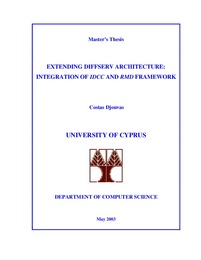| dc.contributor.advisor | Pitsillides, Andreas | en |
| dc.contributor.author | Djouvas, Costas | en |
| dc.coverage.spatial | Cyprus | en |
| dc.creator | Djouvas, Costas | en |
| dc.date.accessioned | 2013-09-16T14:00:35Z | |
| dc.date.available | 2013-09-16T14:00:35Z | |
| dc.date.issued | 2003-05 | |
| dc.identifier.uri | https://gnosis.library.ucy.ac.cy/handle/7/13165 | en |
| dc.description | Thesis (Master) -- University of Cyprus, Faculty of Pure and Applied Sciences, Department of Computer Science, 2003. | en |
| dc.description.abstract | The rapid growth of demands that is being observed during the last few years shows the unavailability of current solutions to provide QoS. Since it is expected that these demands will continue to increase rapidly, much research is conducted so that more effective QoS schemes will be proposed. Current research is focusing on two architectures, the IntServ [6] and the DiffServ [5]. Researchers also understand the need to control the congestion level in the network, since congestion is one of the reasons that current Internet provides poor QoS.
Recently, Resource Management in DiffServ (RMD) and Intergraded Dynamic Congestion Control (IDCC), two schemes, which aim at providing QoS, were proposed. Each one is focusing on a different issue that must be solved, in the context of QoS. RMD proposed in [1], extends the DiffServ principles with new ones, necessary to provide dynamic resource management and admission control in DiffServ domain. IDCC is controlling the traffic using information on the status of each queue in the network. It is based on a nonlinear model of the network that is generated using fluid flow consideration [16, 26, 27, 28]. Both schemes, RMD and IDCC, are using the basic principles of DiffServ architecture to aggregate the flow to classes.
The aim of this Master Thesis is to integrate RMD and IDCC, in a more effective scheme, which will use the same framework and will be able to handle both real time and elastic applications. The basic goal is to secure high utilization and bounded delay and loss. Furthermore, the network is to comply with the demands each traffic class sets.
In order to evaluate the proposed scheme, NS-2 simulator was used. The simulation results demonstrate the effectiveness of the integrated RMD - IDCC scheme, since it secures all the desired network behavior and especially the expected high utilization, and bounded delay and loss. | en |
| dc.format.extent | iv, 63 p. : ill. ; 30 cm. | en |
| dc.language.iso | eng | en |
| dc.publisher | Πανεπιστήμιο Κύπρου, Σχολή Θετικών και Εφαρμοσμένων Επιστημών / University of Cyprus, Faculty of Pure and Applied Sciences | |
| dc.rights | info:eu-repo/semantics/openAccess | en |
| dc.source.uri | https://ktree.cs.ucy.ac.cy/action.php?kt_path_info=ktcore.actions.document.view&fDocumentId=5438 | en |
| dc.title | Extending diffserv architecture: integration of idcc and rmd framework | en |
| dc.type | info:eu-repo/semantics/masterThesis | en |
| dc.contributor.department | Τμήμα Πληροφορικής / Department of Computer Science | |
| dc.author.faculty | Σχολή Θετικών και Εφαρμοσμένων Επιστημών / Faculty of Pure and Applied Sciences | |
| dc.author.department | Τμήμα Πληροφορικής / Department of Computer Science | |
| dc.type.uhtype | Master Thesis | en |
| dc.contributor.orcid | Pitsillides, Andreas [0000-0001-5072-2851] | |

